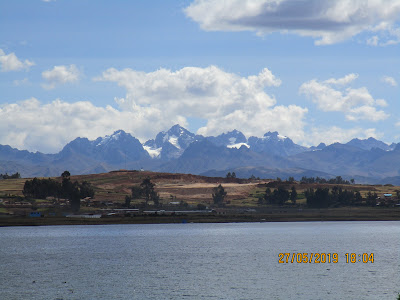Our first stop was Ollantaytambo Archaeological Park. The archaeological complex of Ollantaytambo was a military, religious and agricultural centre. It dates back to the reign of the 15th Emperor Pachacuti who conquered the region and contains some of Peru's best-preserved Inca ruins. It was the site of a major battle, one of the successful ones against the Spanish conquistadors. However it was soon captured by Pizarro and his men. Our group, except Charlotte and me, climbed the Inca steps to the top of the fortress. Charlotte and I explored down below.
Sarah, above, Bev and Jim, below, at Sanctuary Doorway.
This is the uncompleted Temple of the Sun, specifically the Wall of the Six Monoliths. Each of these stones weighs 50 tons and they were brought from the nearby quarry. The Temple of the Sun was like a calendar for the Incas and was of specific importance on the 21st June, the winter solstice, and the 21st of december, the summer solstice.
I think the mountain with the glacier is Mount Veronica.
This is the Bath of the Princess Fountain.
While we were here there was a man playing pan pipes - it was really good and very atmospheric.
Definitely Mount Veronica.
The terraces are split by multiple staircases that extend upward like the spokes of a wheel enabling people to walk from the top to the bottom. There is a vast difference in temperature between the top and the bottom of the structure - as much as 15 degrees centigrade.This difference in temperature created micro climates which may have been used by the Incas to study the effects of different climatic conditions on crops. It's like they were experimenting to see what grew best where. The Incas were obviously very advanced in scientific thinking.
A gorgeous view of Veronica mountain, the highest peak in the Urubamba mountain range (5, 860 metres/19,226 feet). It is covered in snow for modst of the year.
We next stopped above the salt flats of Maras which were equally fascinating. The Salinas de Maras were first created sometime in the 14th century. The collection of around 3,000 pools cascade down a hillside valley like uneven steps. They are fed by a subterranean stream that flows through an intricate system of channels and they are left to dry. As the water evaporates a thick layer of salt is left behind and is then gathered and bagged for sale. A (seemingly famous) chef, Gaston Acurio, proclaimed Maras salt as some of the best in Peru and uses it in his dishes. As a result it is found on the tables of the best restaurants in Peru.
It was a beautiful setting and we had lunch in a covered area. Lunch was quinoa salad, smoked salmon, chicken, potatoes and vegetables, fresh fruit and a glass of white wine Sarah had a huge fish to herself! That's what I call an effortless and substantial picnic!
Lotte was still sick so she slept in the hammock.
We continued on our way back to Cusco where we went out for dinner in Chicha - and I have just discovered that this is one of the famous chef Gaston Acurio's restaurants and it was very good too! However, if I'd known it was famous I might have had something other than pizza (but very good pizza!) However it was 4 flights up so breathlessness took away a bit from it. It was in a lovely old house with blue-painted balconies overlooking the fountains of Plaza de Regocijos. We got a taxi home and Sarah walked. Jim was fast asleep by 8.30pm.









































































very nice blog and very good information you are providing to us i need more blog like that and i have also similar blog want to read so click here Best Restaurants in Netaji Subhash Place
ReplyDeleteone of the best blog with many informative information similar i have also want to read so click here Best Restaurants in Netaji Subhash Place
ReplyDelete